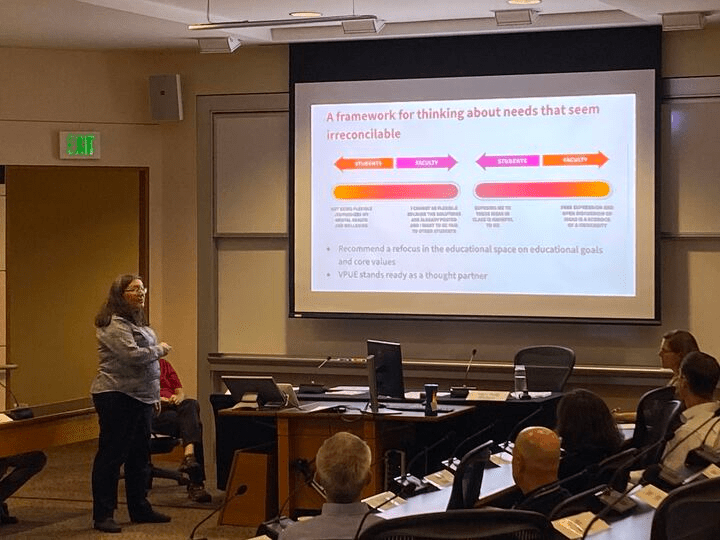The Faculty Senate held their second meeting of the quarter on Thursday, offering updates on the presidential search and discussing happenings within the Office of the Vice Provost for Undergraduate Education (VPUE).
The Senate also acknowledged eight faculty members as Bass University Fellows, an honor recognizing “extraordinary contributions to the university’s undergraduate education.”
Presidential search committee
Representatives from the presidential search committee — co-chairs professor Bonnie Maldonado M.D. ’81, Lily Sarafan ’03 M.S. ’03 and Gene Sykes MBA ’84 and trustee Jerry Yang ’90 M.S. ’90 — provided an update on the committee’s progress.
The committee is comprised of trustees, faculty members and staff, in addition to an undergraduate student, a graduate student and a postdoctoral student. The committee also hired the outside search firm Isaacs and Miller.
According to the representatives, the committee is in the first phase of the search process: community engagement.
“In this phase of the process, our goal is to understand the community’s expectations and aspirations for our next president,” Sarafan said. “We aim to cast a very wide net and also listen deeply.”
The representatives reported active engagement in the committee survey sent out on Oct. 12, with approximately 1,000 responses from the campus community and approximately 3,400 responses from alumni and parents of undergraduate students. The survey will remain open until Oct. 27.
Following their update, the representatives posed three questions for the Senate: What should the next president understand about Stanford in order to be successful? What are the key issues, challenges and opportunities the next president will face? And what goals, values and/or capabilities should the next president have to lead Stanford?
Many members said the next president should be deeply connected to and committed to the university community.
Law and history professor Amalia Kessler said she hoped the next president would act authentically: “The University president should be someone who really is also at core, a teacher and a scholar, who understands the core mission and speaks in ways that feel authentic.”
ASSU Executive President Sophia Danielpour ’24 said she hoped the next president would be “emotional and empathetic.”
“I think a big part of being a leader or being a president at Stanford is coming up with a message and tone that you want to set for that community and being a human and delivering it,” Danielpour said.
Biology professor Patricia Jones said she hoped the next president would be visible and approachable to faculty and students. Jones reflected on former president, John Hennessy, whose model she admired.
“A number of years ago, [Hennessy] made a habit of meeting with all faculty and so every week he would have a small lunch at the Faculty Club where he really listened to them,” Jones said. “In any given lunch, there were people from across the institution, and he would really listen and take notes and they felt that he was paying attention.”
The second phase, which will begin after the survey has closed, will entail building the candidate pool, defining the range of candidates and ultimately narrowing the pool to select several candidates for interviews.
VPUE updates
Vice Provost Sarah Church, who will step down at the end of this quarter, outlined the guiding priorities for VPUE during the meeting, which include supporting and leading in the undergraduate space, equalizing educational access and opportunities for all students, fostering academic wellness and revitalizing the residential liberal education experience.
“We [VPUE] are the liberal education stewards,” Church said.
Church noted accomplishments in the VPUE’s work toward the residential liberal education experience, including the success of COLLEGE, a required freshman course surrounding the importance of a liberal education. Last year, the duration of COLLEGE was increased from one quarter to two quarters.
“[COLLEGE] is going to be one of the ways we talk to students early and often about having difficult conversations, living in communities, all those good things,” Church said.
Church also touched on the Leveling the Learning Landscape Initiative, a multi-year effort to make undergraduate curriculum more equitable and accessible. The Stanford Summer Fellows Program (SSFP) was created under the initiative, granting 35 first-generation low-income rising sophomores summer research and internship opportunities.
Also created under the initiative was a partnership between six faculty teams and the Center for Teaching and Learning (CTL), which worked to reimagine the university’s introductory curriculum to better support the range of preparation within first-year students. The partnership has received funding for the remainder of the academic year.
Church spoke further on the Academic and Residential Co-Curricular (ARC) Initiative, which connects undergraduate students with faculty members through extracurricular programming.
“We want every student who comes to Stanford to have the same opportunity as every other student: to participate in this wonderful educational experience,” Church said. “That means providing the right kind of support for students.”
Church concluded by outlining further goals for VPUE: consistent practices around academic support for students with accessibility challenges, consistent practices supporting student athletes in a changing national landscape and tackling increased friction between faculty and students in a classroom which she said ranged from disagreement over class content to deadline flexibility.
The Senate also acknowledged the appointments of several faculty members as new and returning Bass Fellows.
